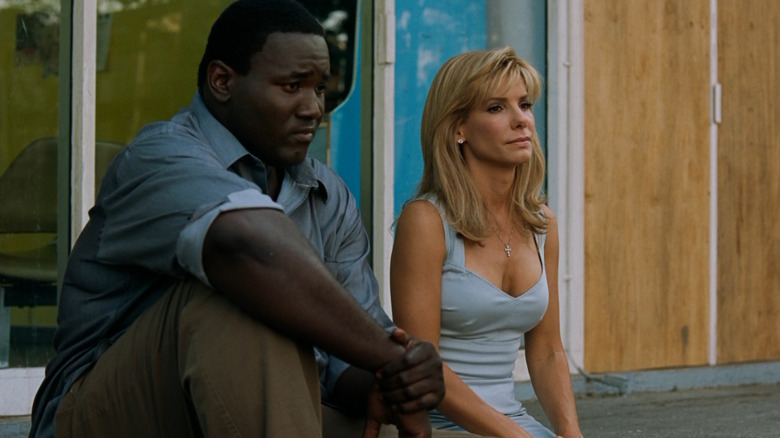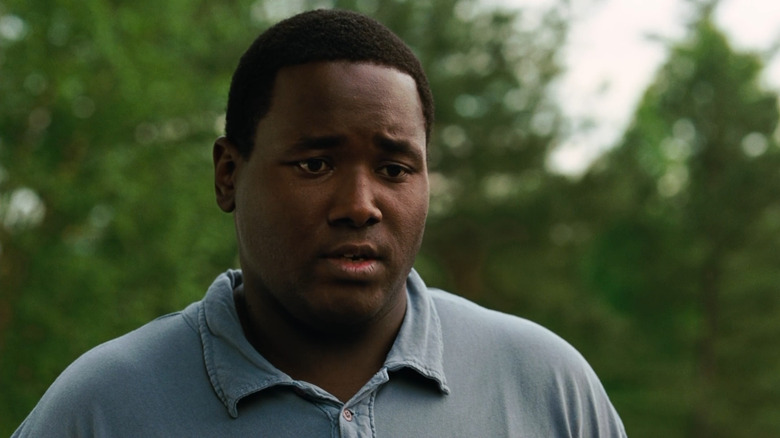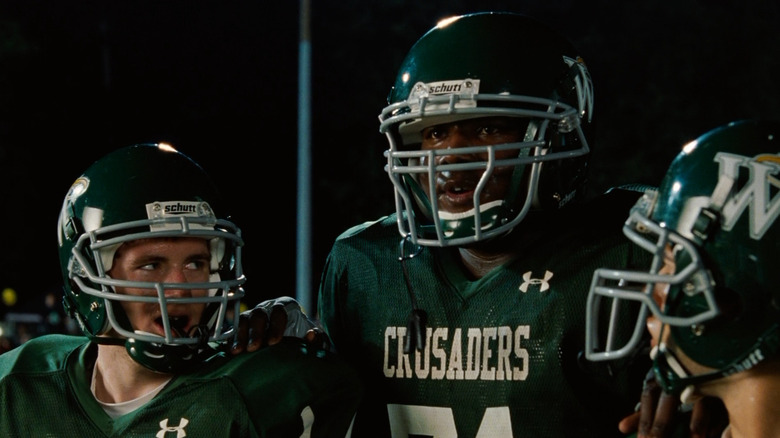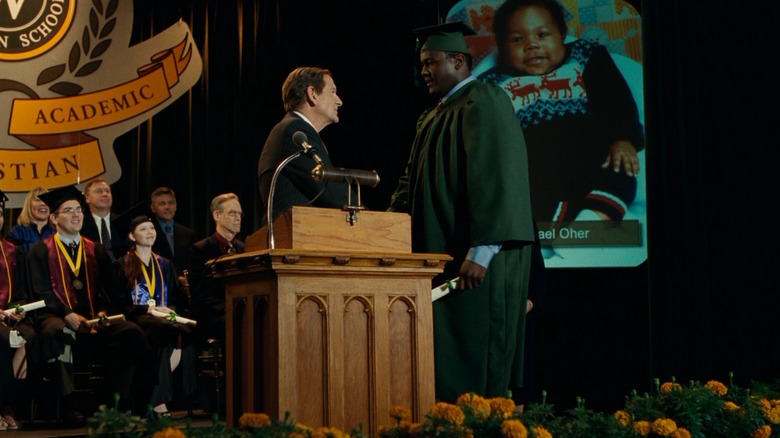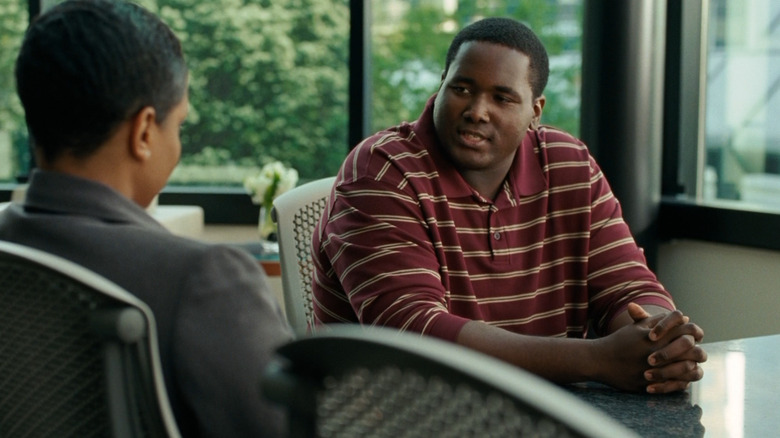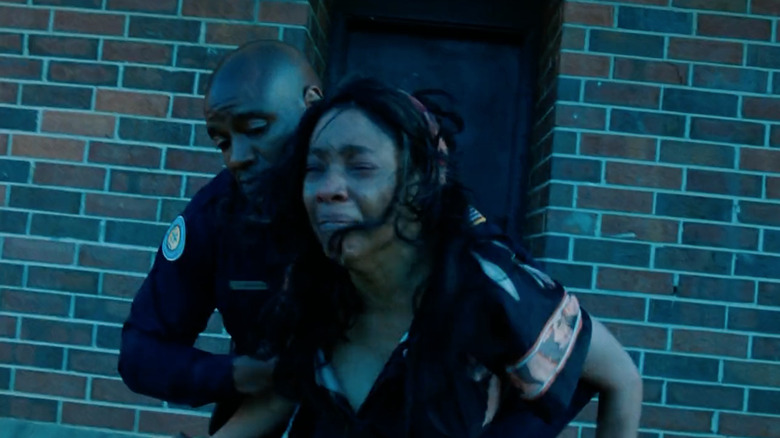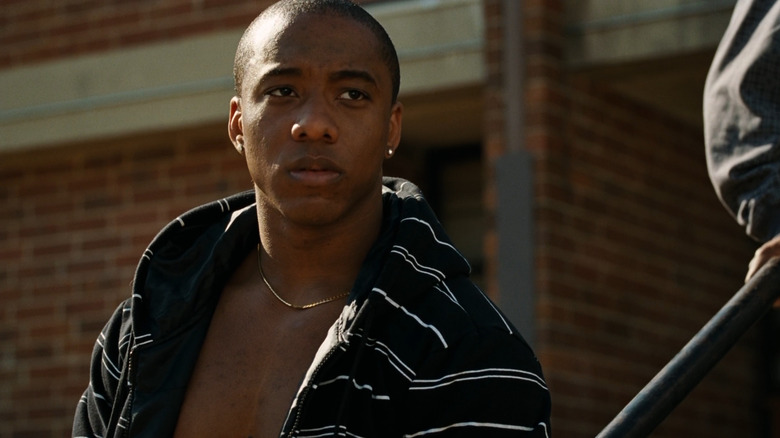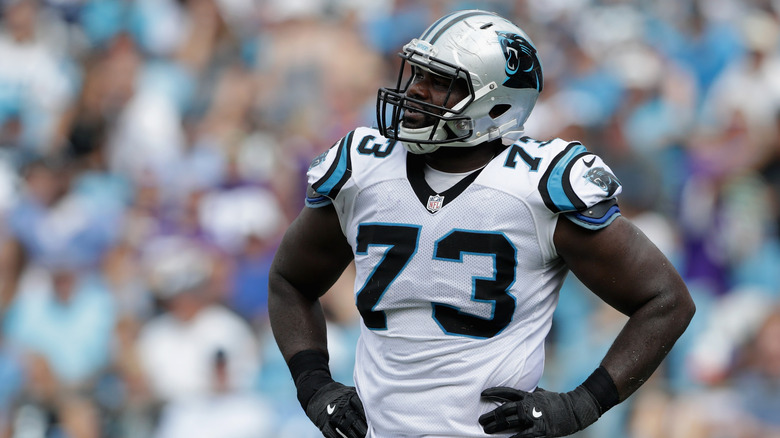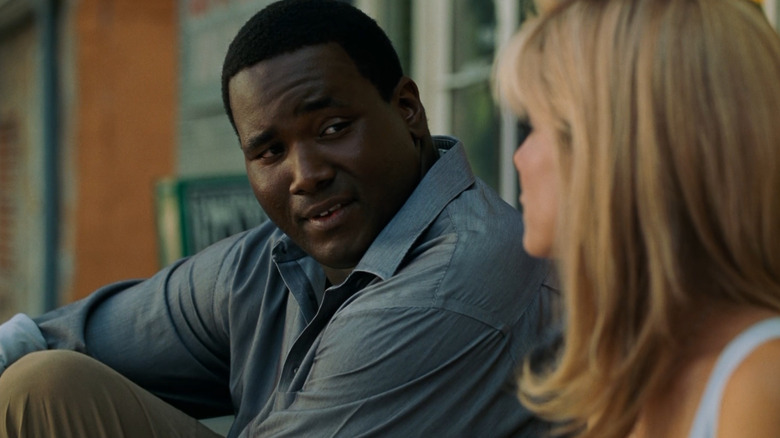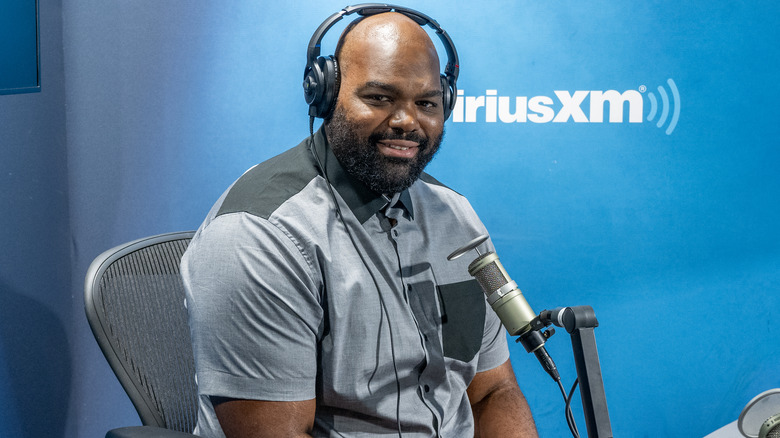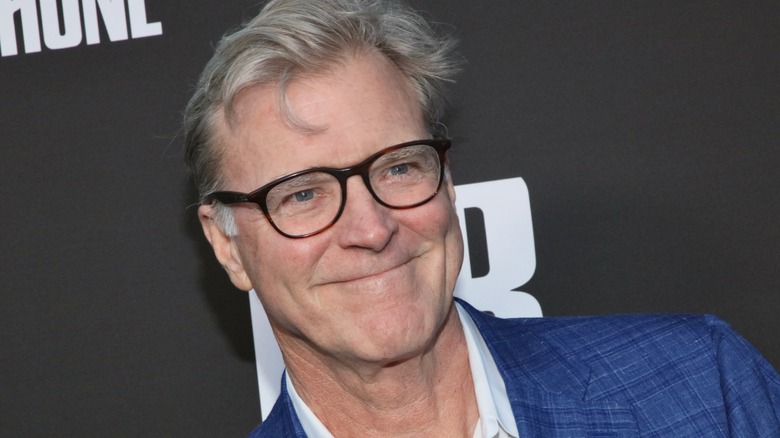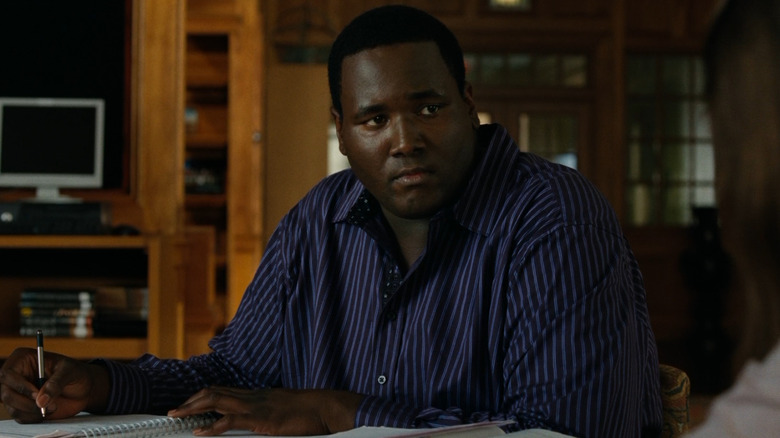The Ending Of The Blind Side Explained
A successful sports biopic often recounts the dramatic tale of a future superstar as they struggle against adversity to reach the top. The 2009 film "The Blind Side" does it in a unique way, focusing on the teenage years of Michael Oher (Quinton Aaron), a young man with a difficult past who finds a bond with a wealthy suburban mother, Leigh Anne Tuohy (Sandra Bullock), and her family. Along the way he develops a career in football, eventually gaining the attention of colleges around the country.
The film begins with Oher living on the streets, facing some of the biggest problems any teen ever could. But unlike most sports biopics, the film ends before he even becomes a star in his sport. Instead, the focus of the film is squarely on the drama of Oher growing up and finding out who he really is. It chronicles the relationship he builds with Leigh Anne and her family, who take him in when he has nowhere else to go and guide him into a future he could never have had without them.
As remarkable as the film is, though, what might be most incredible is that it remains today the highest-grossing sports movie ever domestically. It's also been at the center of real-life drama, too, as Oher has long disputed many of the details of the film. But no matter how true the story is to life, Oher's journey in "The Blind Side" is a classic underdog story, and we've broken down the film's ending to help understand what it's all about.
What you need to know about The Blind Side
A teenage orphan, Michael "Big Mike" Oher spent his childhood in a rough part of town and since then has been bounced around from school to school. A friend's father (Omar J. Dorsey) helps convince a local Christian school to enroll him thanks to his impressive size — which makes him the envy of the school's athletic program director (Ray McKinnon). But once Oher starts attending, he clearly sticks out like a sore thumb: This is an all-white, upper-class Southern school where most of the students come from privileged homes.
Sorely underestimated by everyone, Oher is mistaken for being unintelligent and even slow-witted, but beneath the surface, he's a bright young man with a big heart who has simply never had the opportunity to flourish. Before long, Mike comes to the attention of Leigh Anne Tuohy, who takes the orphan into her home and makes him a part of the family. Leigh Anne and her husband Sean (Tim McGraw) push him into pursuing football while he works to improve his grades, and when he begins to excel on the field, he gains attention from the biggest names in college football.
The only problem is that Oher's grades still aren't good enough to qualify. To have a future on the field, Oher will need the support of his new family. At the same time, though, Michael is also struggling with demons from his past that have haunted him since he was a child and have left deep scars that he has never healed from.
What happened at the end of The Blind Side
With the prospect of her newly adopted son missing out on a future as a college football player, Leigh Anne is determined to help Michael get his grades high enough to qualify for a college athletic scholarship. She hires a local tutor, Miss Sue (Kathy Bates), who helps him write a year-end essay to get his GPA to where it needs to be. All the while, Michael is being pursued by college recruiters from every major school, including Louisiana State University, Texas A&M, and even Ole Miss — his adoptive parents' alma mater.
Following a tense negotiation with various recruiters, Michael indeed chooses Ole Miss, but that choice brings an investigation from officials who believe he may have been coerced by the Tuohys for their own personal gain. Confused by both sides, Michael begins to doubt everything that the Tuohys have done for him, and to clear his head goes back to Hurt Village, the inner city project housing he grew up in. There, he gets into a tense and violent confrontation with a local drug dealer (IronE Singleton) which finally helps him come to terms with his troubling past.
Now ready to face his future, Michael embraces his adoptive family — figuratively and literally — when he begins his college career at Ole Miss. Over the film's end credits, images of the real-life Michael Oher are shown, as well as footage of his selection in the NFL draft in 2009, mere months before the film was released.
What was the meaning of the Charge of the Light Brigade?
Facing long odds at getting her adopted son's GPA high enough to qualify for college, Leigh Anne Tuohy discovers there's one faculty member who is making it harder for Michael than the rest. He's an English teacher (Tom Nowicki), and he's unwilling to make any exceptions and wants Michael to earn his approval, not get it because his mother has twisted his arm. As fate would have it, a final English essay may be the ticket to getting his grades where they need to be, and after a brief internal struggle, Michael discovers the 19th-century poem, "The Charge of the Light Brigade."
While Michael's adoptive father, Sean, likens the poem's message about soldiers following orders to football players following the instructions of their coaches to form a winning team, Michael has an entirely different — and far more personal — interpretation. To him, the poem's words aren't just about the literal following of orders, but about courage and honor. He thinks about how some of the soldiers must have considered refusing orders but went ahead anyway, knowing they would likely die. That was courage, but for Michael, it was about defining who you are and who you want to be in life, which is precisely what he has been fighting to discover throughout the film.
Through "Charge of the Light Brigade" Michael learns about himself, and how he can make his own choices and decide for himself who he really is.
What was the interview really about?
Following a brief football history lesson narrated by Leigh Anne Tuohy, the first scene of "The Blind Side" is actually a tense interview that sees Michael being grilled by an unknown woman about his "odd predicament." The story then shifts back two years to show how he got to this point, and in the film's final act, we learn more about that meeting. Following his acceptance to Ole Miss, he's brought in to be questioned about why he's chosen to attend.
The woman asking the questions is an investigator named Granger (Sharon Conley) who has serious concerns about the Tuohys' role in Michael's attendance at Ole Miss. According to Granger, some believe that the Tuohys had orchestrated events in an effort to help their alma mater, for whom they are significant donors. Granger even suggests that the help they gave him over the last two years was a ruse and that he was chosen specifically to become an athlete who could help their former school.
Granger wasn't just worried about the legality of the Tuohys' actions either: She was even more concerned about setting a dangerous precedent where wealthy families could seek out impoverished young men who they could groom into athletes and send off to prominent schools in the South as a corrupt college recruiting scheme. But while there are hints in the film that the Tuohys pressured Michael into choosing Ole Miss, there's no evidence that they took him in for any other reason than charity.
What really happened in Michael's past
Throughout "The Blind Side" we're given very brief glimpses of Michael Oher's early days and the trauma he faced as a child. Early on we learn that Michael's mother was addicted to drugs and his father likely had a criminal record. Later, we meet his mother in the present day, when Leigh Anne goes to visit her to find out about his youth.
There, we learn that Michael's mother had a dozen children or more and could barely keep track of who the different fathers were. She does, however, show a genuine concern for Michael's well-being and reveals that after he was removed from her care by the state, he repeatedly ran from foster families trying to find her. In a final flashback during the ending of the film, we see in more detail the day that Michael was taken from his mother, and a close look reveals he was also removed alongside at least one of his brothers — possibly Marcus, with whom he briefly reunited earlier.
We also learn the one lesson his mother taught him that helped him become the gentle giant he is — much like Ferdinand the Bull, the hero of the children's book Leigh Anne had read to him. In times of stress or crisis, Michael's mother told him to close his eyes, count to three, and remember that "The past is gone, the world is a good place, and it's all going to be OK."
Who was the young man who was killed at the end of The Blind Side?
In something of an epilogue, the final moments of "The Blind Side" include a series of newspaper clippings about deaths at Hurt Village, the housing projects where Michael grew up. As Leigh Anne narrates, she talks about how one young man who'd been murdered was noted to have had superb athletic ability just like Michael, and that if things had been only just a little bit different, that could have been her adopted son laying dead in the street.
While the paper clippings flash across the screen that show stories about violence in Hurt Village, the camera lingers on the photo of one young man who was recently murdered, before cutting to a previous moment in the film. It shows one of the project residents named Dave (Hampton Fluker), a quieter, less violent friend of the drug dealer Michael had fought with earlier. Sadly, it seems that Dave — whom Michael clearly considered a friend, as he was the only person he greeted when he first arrived at Hurt Village — lost his life to the violence of the streets. He's not the only one, though, as several pictures of murdered inner-city kids flash across the newspaper headlines. These individuals were unable to escape the hard life on the streets the way Michael had, making the sequence a stark reminder of the vast difference that one kind act can have on a person's life.
What happened to the real Michael Oher after he went to college?
A well-timed production, "The Blind Side" was filmed and released just as the real-life Michael Oher was getting his professional football career started in the NFL. As teased at the end of the film, he was drafted into the league in the spring of 2009 with the 23rd selection by the Baltimore Ravens, joining the team as their left tackle. He earned that pick thanks to a strong tenure playing college ball at Ole Miss that saw him named the Southeast Offensive Lineman of the Year in 2008.
Oher later distinguished himself in the NFL as well, coming in second in the NFL Offensive Rookie of the Year voting in 2009. Three years later he'd help lead the Ravens in their Super Bowl trophy-winning season in 2012, where played right tackle in the Ravens' 34-31 victory over the San Francisco 49ers. In fact, "The Blind Side" actress Sandra Bullock famously showed up to the big game and greeted Oher with a big hug, having kept up a close relationship with him since making the movie.
After five seasons with Baltimore, Oher hit free agency and cleaned up, signing a four-year deal with the Tennessee Titans worth $20 million. Released by the Titans in 2015, he moved on to the Carolina Panthers on a two-year, $7-million deal where he made a comeback, ultimately signing a three-year, $21.6 million dollar extension in 2016. In 2017, Oher officially retired following a wildly successful 8-year career.
What the ending of The Blind Side doesn't tell you about the true story
"The Blind Side" leaves out many important details in the life of Michael Oher and changed significant elements to make the man's story more dramatic for the movies. Perhaps most fundamentally, the film makes it seem like Oher had no idea how to play football when he first attended Wingate Christian School, even needing help from his adopted little brother Sean Jr. (Jae Head) just to learn the basics. But in reality, Oher had been playing football for years.
When it comes to the ending of "The Blind Side," though, it's the climactic confrontation with gang members at Hurt Village that stands out as the movie's biggest invention. In real life, there was no such fight because Michael never actually returned to his old stomping grounds on the eve of his college acceptance. The entire sequence was written just for the movie to serve as a dramatic turning point for the fictional version of Michael Oher as he faces up to his past and decides to look ahead to his future. This is just one of many times "The Blind Side" lied to us, though.
The movie also never mentioned the fact that Oher used online courses from Brigham Young University to improve his grades to qualify for college. Those courses, and Oher specifically, came under fire in 2006, criticized for using underhanded tactics to make poor-performing students college-eligible.
What does the real Michael Oher think about The Blind Side?
When "The Blind Side" hit theaters it earned big box office bucks, strong reviews, and Sandra Bullock a win for best actress at the Academy Awards. But sadly, the man whose life the movie was based on has always seemed somewhat bitter about the way he was shown in the film. "I felt like it [the movie] portrayed me as dumb instead of as a kid who had never had consistent academic instruction and ended up thriving once he got it," he wrote in his memoir, "I Beat The Odds: From Homelessness, to The Blind Side, and Beyond."
It wasn't just the skewing of his personality that rubbed Oher the wrong way, though. He also believes that his depiction as someone who never quite understood the game of football wound up hurting him during his NFL career. "People look at me, and they take things away from me because of a movie," he told ESPN (via The AV Club). "They don't really see the skills and the kind of player I am. That's why I get downgraded so much, because of something off the field."
Despite signing several big-money contracts in the pros and even winning a Super Bowl ring with the Ravens, Oher feels that the movie — whose ending shows him barely making it into a college program — has hurt perceptions of him, and he said he hates talking about it. "I'm tired of the movie," he said, according to the Los Angeles Times. "I'm here to play football."
What has director John Lee Hancock said about the ending?
"The Blind Side" is based on a true story, but it was actually adapted from the non-fiction book by sports writer Michael Lewis, whose books "Moneyball" and "The Big Short" became hit films not long after. Looking to turn it into a film, Hollywood producers brought the book to writer and director John Lee Hancock, who'd had success a few years before on another underdog sports biopic, the baseball movie "The Rookie." Interviewed about "The Blindside," Hancock talked about the overall themes of the story and the message he thought should be taken away by audiences.
"[It's] an unconventional mother-son story," he told Trailer Addict. "I think it's very much about asking the question, 'How did the stars align to shine so brightly on this kid in the projects in Memphis, Tennessee?'" As a story about a homeless teen who is brought in by a wealthy family, the movie has garnered criticism for perpetuating the "white savior" myth, but Hancock sees it very differently.
"It's very much about taking stock of your life on a daily basis, being thankful for the things that you have, and also of being aware of what other people don't have," he said. In the end, Hancock said, the film tells us that it's who we surround ourselves with that gives out life meaning.
How a controversy a decade later gives the ending a dark twist
Since 2009, the real Michael Oher claims he's persistently dodged criticism of his ability thanks to the portrayal of him in "The Blind Side." But in 2023, the story took a dark twist when he filed a lawsuit against the Tuohys, claiming that his adoption by the family — seen midway through the film — was fabricated not for the film, but in real life. In the suit, Oher alleges that Leigh Anne and Sean Tuohy never actually adopted him and instead duped him into signing paperwork giving them control over all of his future business dealings.
While the case is still ongoing and new information is still being revealed, the allegations are an indictment of the Tuohys that would completely shift the way "The Blind Side" is viewed, particularly its ending. Because during the interview seen at the conclusion of the film, the investigator speaking to Oher makes strikingly similar accusations of the family. Alleging that Leigh Anne and Sean Tuohy have used Michael to enrich themselves and their alma mater, Granger is rebuffed by Oher in the film, who believes in the love of his adoptive family.
Oher is claiming that it was only recently, earlier in 2023, that he learned new details about his legal guardianship. Now he said he believes the Tuohys have been profiting off of his story while denying him a share of rightful royalties from the movie and other earnings.
